By Jeffrey A. Rendall; photos by Kevin Gaydosh and Jeff Rendall
SOUTHERN PINES, NC – “It was really a dream come true to work on and be a part of the restoration of Mid Pines,” remarked course architect Kyle Franz, the lead mind behind returning the Donald Ross-designed Mid Pines Golf Club to its original form.
Mid Pines’ 2013 restoration followed on the heels of the legendary Pinehurst #2’s in 2010, a reworking of the timeless championship layout that engendered so much discussion in golf architecture circles. The trend in restoring classic golf courses is to return them to their original strategy and aesthetics – and you can certainly include Mid Pines in the category of tracks that seem brand new after receiving a retro makeover.
Mid Pines opened in 1921 and was thought to have been virtually unchanged since that time. True, the routing remained the same throughout the years, though as Franz explains below, the course had actually gotten away from some of its unique strategic elements Donald Ross worked so hard to install.
Ninety years of history is a long time for a golf course. Mid Pines was always a terrific place to play, though with the improvements made by Franz and the owners, it’s even better. Seeing as the restoration was Franz’s first solo project, the end result is even more impressive.
We recently caught up with Kyle Franz and asked him to expand on his outstanding work at Mid Pines. His explanations were so thorough, we decided to include them in their entirety:
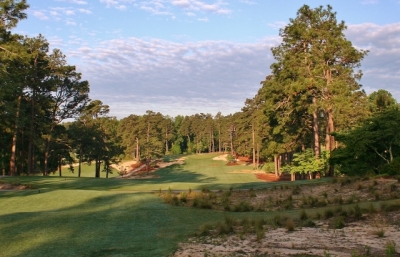 |
| For those who have been to Mid Pines in the past, you will know right away that it looks a lot different now. Here, the first tee. |
GolfTheUnitedStates.com: Tell us a little bit about your background in design. Since Mid Pines was your first solo project, did you study under other architects?
Franz: I've been very lucky in my career!
I've worked on many great projects, and for many great architects. I was fortunate to have worked on two of the three highest rated courses built in the last eighty years at Pacific Dunes and Barnbougle Dunes (Australia) for Tom Doak. I worked at Pinehurst #2 for Bill Coore and Ben Crenshaw. I also just finished up working on the 2016 Olympics Course in Rio de Janeiro, Brazil for Gil Hanse Golf Design.
In addition, I worked for Rod Whitman at Cabot Links, Tim Liddy at the Dukes Course St. Andrews, Tom Lehman and Chris Brands at The Prairie Club, and Kyle Phillips at California Golf Club. All in all, I've worked on an enormously diverse set of projects and restorations including eight courses in the Top 100 World, US, and UK course rankings.
Within that I've worked on restorations of the fine works of four golden age architects.
My work and travel has enabled me to visit and study many of the top 100 courses in the world and spend a year overseas studying the great golf courses of the British Isles.
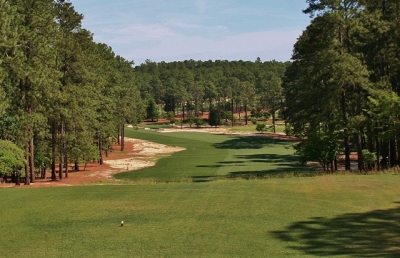 |
| The elevated tee of the par four 16th hole offers a spectacular view. |
GolfTheUnitedStates.com: You partially just answered this, but had you worked on other Donald Ross courses in the past?
Franz: Yes, Pinehurst was a perfect prelude for doing the eventual work at Mid Pines.
I did a lot of our photography research in the Tuft Archives that we used during the Pinehurst #2 restoration. I also did much of the shaping and construction work on the project. Through this work I became very well acquainted with Donald Ross's life-long labor of love with #2 and other Pinehurst area courses.
It gave me a great understanding of his style and how it evolved over forty years here. The work at #2 greatly affected how I approached Mid Pines, and I tried to give it a subtle atmosphere all its own within Ross's Pinehurst style.
GolfTheUnitedStates.com: Architects are relying quite a bit on aerial photography for classic course restorations these days. Was that the case at Mid Pines? If not, how were you able to determine what was there before?
Franz: Yes, however with a twist.
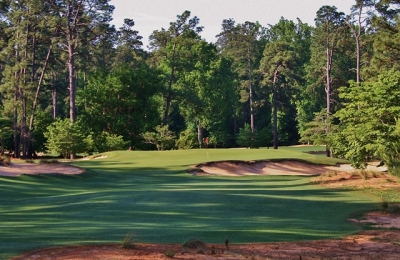 |
| The downhill par three 8th is rated the easiest on the front nine, but it is not a pushover. |
One of the biggest mistakes I see restoration projects make these days is following the aerial religiously, but not quite catching on to the intent of the original architect. The best of restoration work is not to just paint by numbers -- it carefully analyzes the concepts and restores the intent and details of the holes.
Most importantly, it applies it to the modern game.
The details of restoration make the real difference in the final result and maximizing the potential of the course. It sounds simple, but it’s more difficult than one might guess. All that said, the aerial I used for Mid Pines was from 1939, and a number of other resources including 1920's partial aerials/ground photos.
I improvised it in areas. We were able to draw a bit of influence from various different periods of Ross's Pinehurst work and also add a bit of drama and strategy in places. Mid Pines is one of the most well preserved Ross courses. But for a variety of reasons (explained below), the nature of the property has evolved over 90 years of use.
So the restoration of Mid Pines required a bit more improvisation than at Pinehurst #2. My previous experience there was helpful with the evaluation and design work.
GolfTheUnitedStates.com: What "new" elements would you say were incorporated into the Mid Pines design (new grasses, tees, etc...)? For a course restoration, do you seek to create an exact replica of the original or do you go more on the "spirit" of the golf course?
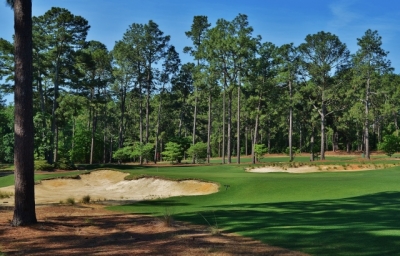 |
| Kyle Franz restored the bunkers to a Donald Ross look. Here, greenside at the par three 13th. |
Franz: As you might suspect from the above answer, it is a bit of both.
To recreate the feel of Ross's holes, we moved, added, or re-added bunkers/and sandy/native wiregrass and other various hazard areas that were part of the original course. We restored the bunkers back to Ross's style to give them the dramatic and rugged natural look. And then we lengthened several holes as well.
Overall, I chose to use Ross's 1930's bunker style, which is slightly higher and flashier than the Pinehurst 1940 era style model we used on #2. It works well with the big views around the hillier property since it is more dramatic at Mid Pines.
However, in some cases, I used the scaling of his 1920's era Pinehurst bunkers -- big bold -- since 1930's Ross bunkers were limited in scale for Great Depression budget restraints. So the intent was to capture the best of both worlds.
And of course, we re-added the iconic sandy hardpan/wiregrass areas that make Pinehurst famous.
We also re-added a number of the hole locations on greens that had shrunk over the years. These hole locations asked players to consider which side of the holes to approach from. This added some exciting new hole locations on many holes.
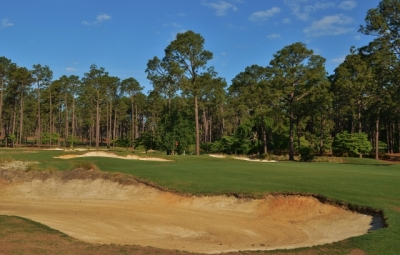 |
| Going for the green in two on the par five 6th demands precision and a steady nerve. |
But what really makes the holes tick are the wide fairways! Every fairway was widened so they would be enjoyable for the average golfer. But even more importantly, widening the fairways afforded us the opportunity to make the holes very strategic, by rewarding the player who can accurately place tee shots on the proper sides of fairways.
In doing so, the player is rewarded with an easier next shot from a better angle. Pinehurst #2 's and Mid Pines fairways are designed to be very wide for those reasons -- playability and strategy.
GolfTheUnitedStates.com: What would you say are the differences between Pinehurst #2 and Mid Pines?
Franz: At Mid Pines, Ross attempted to make the course unique from his others in Pinehurst.
He did so by making Mid Pines’ fairways equally as wide as Pinehurst #2, but made the overall width of tree lines/corridors through the pines noticeably tighter… The corridors average only 50 yards at Mid Pines compared to the spacious 65 yards at Pinehurst #2...
Often there is little or no space between the edge of the fairway and the tree line at Mid Pines.
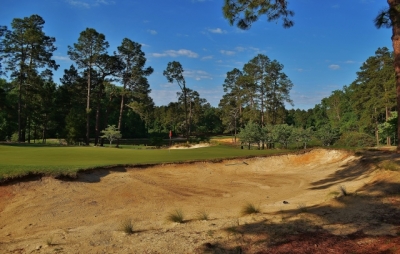 |
| Plenty of sand guards the green of the par five 5th hole. |
With dense thickets of pines closely guarding the holes, coupled with sandy hard-pan, straw, and wiregrass areas, reaching these *good angles for the next shot/honey spots* is risky. It’s riskier at Mid Pines than at his other courses here. It’s an interesting evolution of his design style in Pinehurst.
To expand on that, the original Mid Pines course played through a very dense forest. Because of the style mentioned above, Mid Pines was meant to be very sporty and fun for the low handicap player. One really took their life into their hands attempting to reach the proper sides of the fairways for easier next shots because of the dense forest crowding the holes.
When Mid Pines opened in 1921, Bobby Cruickshank once said he thought it to be the equal of Myopia Golf Club (in Massachusetts) as the hardest golf course in the country. Over the span of ninety years, however, the thickets of pine/wiregrass and underbrush had been slowly thinned for resort play.
But the course is still very heavily treed, even today. So it became a critical part of the design to add or adjust hazards in places to recreate the “death-or-glory” strategy of the holes. I saw this as the most important part of my job -- recreating this feel while not making it too difficult for the average player.
GolfTheUnitedStates.com: We see it as still very friendly to resort players. Can you give an example of how you achieved this balance?
Franz: During the restoration, most holes received a bit of this improvisation to recreate that strategic feel, but the par four seventh is perhaps the most illustrative example.
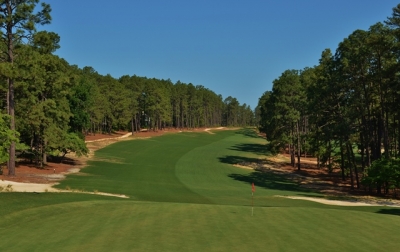 |
| Everything slopes downhill on the par five 15th hole. It will test your shot shaping ability from tee to green. |
The seventh hole’s green was expanded to recapture an excellent front right pin behind the front right greenside bunker. This section of the green had been abandoned over the years as it was too fast for modern green speeds. This pin was one of the original course's best, as it encouraged the players to gamble by appropriately placing their tee shot.
Originally, an accurate drive near the left edge of the tree line gave the player a perfect angle past the front right greenside bunker. Even better, reaching this honey spot gave the player a flat lie -- and the only unobstructed view of the hole.
However, this *honey spot* Ross created was no longer in a part of the fairway by 2010. So we expanded the fairway back out and restored this pin. This encouraged players to try this rout again!
However, we did this with a twist... To reach this 'honey spot," Ross intended you to have to really gamble by playing close to those dense trees, thick underbrush, and wiregrass. But they had been thinned out over ninety years. As a result, I opted to add a bunker/sand hardpan very close to this honey spot... The bunker was precisely located just past this "Honey Spot."
So it really gives the player the impression he can easily avoid it until the fateful day he pulls his tee shot just enough to be swallowed up by the bunker. The overall result is a very fun hole restored to play as originally intended, but not a lost ball factory for the average player.
With a little tail wind, the biggest hitters can try and carry the bunker described above, so it is a hole that really makes players consider things. And the green is one of Ross's best in Pinehurst.
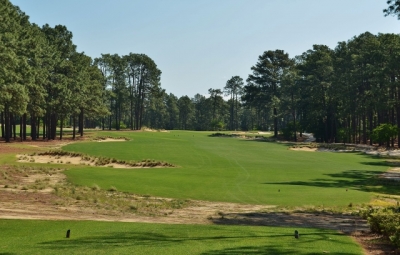 |
| The par four 7th does not look narrow, but you still must position your ball off the tee to afford a good look into the green. |
GolfTheUnitedStates.com: So despite the wide fairways, Mid Pines really does require thoughtful tee shots?
Franz: Absolutely. Many holes are very forceful in asking the players to properly position their tee shots.
Number twelve is one of the most difficult 400 yard par 4's Ross ever built. The approach shot is very difficult over a bunker to a severe green complex from the right side of the fairway. Therefore, it is imperative to play to the left side of the fairway on the tee shot. If one succeeds, the red sea parts and the player has a perfect angle to the green. From there, it becomes a birdie hole.
But Ross meant this to be a very dearly bought advantage by again skirting with a dense thicket of trees, wiregrass and sandy hardpan on the tee shot.
Since the density of underbrush and vegetation no longer exists, we added sandy hardpan, wiregrass and a challenging little bunker in the tee shot landing area on the twelfth for the big hitting modern player to skirt. This was critical to re-establish the “death-or-glory” feel of the tee shot.
The player who pays close attention can avoid all of this trouble by wisely using the sloping fairway to kick balls down to the proper approach position. But to do this, the player must also hit a draw on the tee shot.
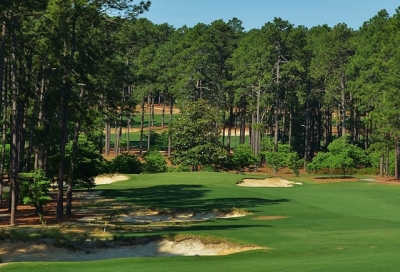 |
| Challenge the trouble on the left off the tee to have a better angle into the sloped green on the par four 12th. |
In contrast, the approach favors a fade. If the player is approaching from the incorrect/right side of the fairway, they will need to be able to hit a fade from a draw lie to have any chance to hold the green. This is a great example of Ross's ability to build a truly great hole on a relatively common piece of sloping ground.
Every hole on the course benefits from some interesting and crafty use of the terrain.
Overall, some holes only required being restored precisely to the original plans. On others, improvisation was most effective. On a few holes, we added features to improve the hole or make it more interesting for modern play. So it was a matter of feel on every hole.
GolfTheUnitedStates.com: What would you say was the biggest challenge at Mid Pines?
Franz: Same things Ross battled -- slightly heavier soils on a couple holes that effect drainage! And we continue to improve that aspect of the course. We have a plan to continue to improve drainage in our second phase of work in the coming years on several holes.
There is an artificial looking pond constructed in 1960's-70's we would like to improve. The pond affects the drainage on the second and third holes. In addition to the drainage issues, we would also like to improve the pond and make it look more natural -- in tune with the rest of the course.
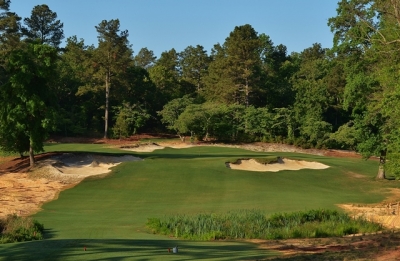 |
| Playing slightly uphill, take enough club to reach the par three 2nd hole. |
GolfTheUnitedStates.com: What will you remember most about working at Mid Pines?
Franz: I love Pinehurst/Southern Pines and the style of architecture Ross created there. The intricate subtlety in this design style is phenomenal.
I fell in love with Mid Pines during the restoration of Pinehurst #2. So the opportunity to restore these subtleties on the course was very personal. Ross considered Mid Pines one of his best and most unique courses and I have no doubts the reason for that is the greens.
Much like with Pinehurst #2, Mid Pines’ greens are interesting to putt, approach, and play recover shots around. The player is presented with a fascinating shot every time he misses a green. Because the greens surrounds are cut at fairway height and bounded by interesting contours, the player has the ability to try a number of creative and challenging shots when off the greens.
They can putt, chip, bump and run, hit flop shots -- sometimes all of them in a span of five holes. Working on a set of Ross greens that were as well preserved as any he built was a special experience.
The fact Ross lived in Pinehurst and had very little other work the year they were created meant he was on site for construction as much as any course he ever built.
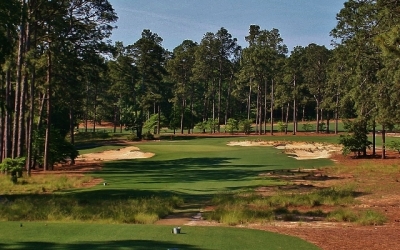 |
| The smart shot on the long par three 13th is to land it short and right of the green and let it roll on. |
Mid Pines, much like Pinehurst #2, was a labor of love for him. So it is no surprise that Mid Pines’ greens are one of his best sets. It was exciting and important to preserve them and put back lost elements of these greens where they had shrunk over time.
Lastly, Mid Pines is unique from Pinehurst #2 on the style of approach play. On many holes, there is a covert advantage to land short and well away from the hole on the approach shots in order to allow the contours to bounce the ball onto the green around bunkers -- instead of trying a risky aerial shot that must narrowly carry a bunker and stop on a dime.
Perhaps the best example is the long and difficult par three 13th. A shot played short/right of the green with a draw will bounce off the sloping green approach and onto the green -- while avoiding one of the deepest bunkers on the course.
Another exciting example of this is the fascinating par four 4th. It is a favorite among architecture aficionados.
The crafty player can approach the green by hitting a low running shot short and left of the green that will curl down the hillside safely around the front bunker and onto the green. Ross wisely placed a contour in the green that further aids in this process by further propelling balls to the hole.
Again, a covert advantage to playing on the ground instead of trying a risky aerial shot that must narrowly carry a bunker and stop on a dime.
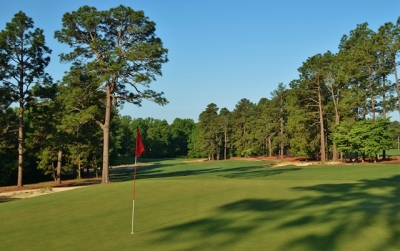 |
| It is hard to tell from this view, but the green of the short par four 4th hole is extremely tricky. |
Fine ground game architecture!
Overall, Mid Pines is one of his most well preserved courses and we hope to only continue to improve that in the coming years!
_____________________________________________________________________________
The restored Mid Pines plays like a Ross Course, but what exactly does that mean?
Graham Gilmore (Director of Golf) helps explain it: “Ross worked hard in all his designs to make sure that better players were challenged, yet those who weren’t as skilled could still come out and play the game and have fun. When you look at a Ross golf hole, he’ll almost always provide choices on how you want to play a shot. The emphasis is rarely on how hard and far you can hit the ball, but instead on how you need to assess every situation.”
As Franz hinted, that’s most evident around the putting surfaces. We’ve all heard how Ross’s greens are domed or turtle-backed, but that’s far too simple to characterize a man who wanted to emphasize skill with short shots – the ‘scoring’ shots in golf.
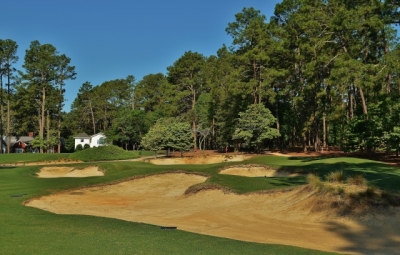 |
| The relatively short par five 10th hole is a pushover until you get closer to the green. |
Ross was the master of the concept of easy-bogey, difficult par, meaning the occasional players aren’t punished too severely for wayward accuracy, but the best players aren’t given a pass for failing to execute what the circumstances demand.
It also involves creativity with the short game. Mid Pines’ green surrounds are tightly mowed, as they were originally intended to be, a throwback to Ross’s Scottish roots where deep, fluffy rough just wouldn’t grow in those types of conditions. Ross liked the ball played close to the ground, and you’ll work to come up with ways to best get your ball close to the hole when you miss a green.
“You can bump and run it, chip it, pitch it, hit it up into the air, or even putt it from 20 yards off the green. Very rarely is it all or nothing with Ross,” Gilmore said. “However, you need to decide where you’re aiming, because of the roll-offs on the edges. Most people think Ross designed greens that way to make it more difficult, but in those days, it was more of an engineering function than anything. Greens back then obviously didn’t have the complex drainage mechanisms that they do now – he just wanted to get rid of water.”
“But those odd shaped greens have become a design feature now, especially with these newer strains of bentgrass that can be cut so short. It just adds an extra element of difficulty to every shot, knowing that if you’re not playing the right strategy, you can very easily be in a worse situation than from where you started,” Gilmore added, talking about how to deal with the rounded edges.
The ‘Open Doctor,’ Golf Architect Rees Jones once said the Ross-type greens are the only kind where short-siding yourself is actually a good thing, since you have more margin for error when playing back up towards the hole. It’s the truth, and that’s the type of thinking you need to employ at Mid Pines.
As a final note, South African Bobby Locke won his first American tournament at Mid Pines in the forties, and Julius Boros won three major championships while serving as the club’s Head Professional (he married into the family that owned Mid Pines at the time).
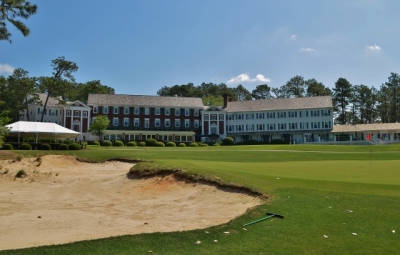 |
| The historic Mid Pines Inn dominates the view from the green of the finishing hole. |
The clubhouse is loaded with old photos – it’s worth checking out after your round.
Like Pinehurst Resort, Mid Pines (and Pine Needles) is a special place. There aren’t many places you can go to get such a tangible piece of golfing history along with all the luxury and service provided by owner Peggy Kirk Bell and the staff.
It’s a place we’ll enjoy going back to again and again.
For a closer look at Pine Needles, which received its own restoration, click here.
Details:
1010 Midland Road
Southern Pines, NC 28387
Website: www.pineneedles-midpines.com; email: info@rossresorts.com
Course Designer: Donald Ross (1921)
Course Restoration: Kyle Franz (2013)
Director of Golf: Graham Gilmore, PGA
Tees/Yardage/Slope/Rating (Par 72)
Blue: 6723 130/71.7
White: 6171 128/69.8
Green: 5669 120/66.3
Red: 4913 120/68.4
Note: There’s a caddy program available on an advanced reservation basis.
To really get the Ross experience, try walking the courses. Walking is unrestricted, and trolleys or pull-carts are available for loan – or smaller, carrying-friendly golf bags if you prefer.
Rates:
Consult the website. Packages also available with hotel accommodations at Pine Needles or Mid Pines.
Rates include range balls. Packages include breakfast and dinner as well.
| Related Links | Comments on this article? | |
|
Maryland National Golf Club Hollow Creek Golf Club Rocky Gap Resort PB Dye Golf Club in Ijamsville Whiskey Creek Golf Club |
E-mail Jeff Rendall, Editor: jrendall@golftheunitedstates.com |












